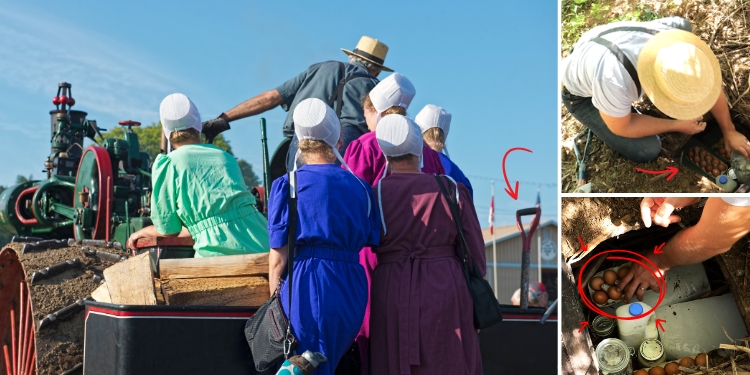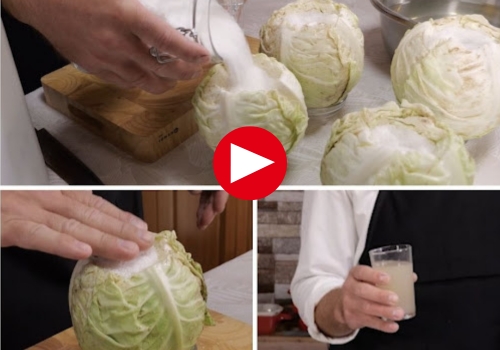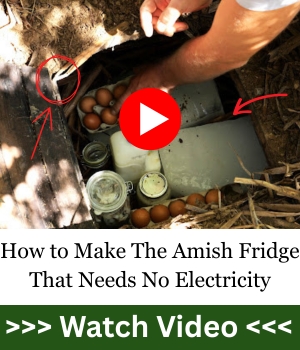The Amish have quietly preserved a way of life that values simplicity, self-reliance, and the natural rhythms of the earth. They offer a time-tested, proven example of how to not just survive, but thrive off the grid.
One of their lesser-known but deeply practical traditions is burying food—a method rooted in both necessity and wisdom. For the Amish, this practice isn’t just a charming relic of the past; it’s a critical survival technique that you might want to consider adding to your preparedness strategy.
Why the Amish Bury Their Food
The Amish practice of burying their food is a survival strategy that helps them live off the grid and maintain their high level of self-reliance. Though some finer points might help you integrate the practice.
Staying Off the Grid
Most Amish communities live entirely without electricity or rely only on limited solar or gas power. This means no refrigerators, freezers, or electric dehydrators. To keep food fresh year-round, they rely on the soil’s insulating properties.
A few feet below the surface, temperatures remain consistent throughout the year, typically between 45 to 55°F. This is great for storing many root vegetables, canned goods, and even canned meat.
Self-Reliance & Frugality
 For the Amish, burying food is also about resourcefulness. Why spend money on ice, fuel, or modern tech when the ground under your feet offers reliable refrigeration for free? This low-tech approach aligns with their values of wasting nothing, living humbly, and relying on the land.
For the Amish, burying food is also about resourcefulness. Why spend money on ice, fuel, or modern tech when the ground under your feet offers reliable refrigeration for free? This low-tech approach aligns with their values of wasting nothing, living humbly, and relying on the land.
Maintaining a Safe Food Reserve
For the Amish, a barn or a house can burn down. A tornado can ravage their community, or bright can decimate their summer crops. Yet food stored in the ground is usually incredibly safe. This gives them the nourishment they need for the time they need to rebuild their basic way of life.
Preservation of Tradition
Burying food is a tradition passed down through generations. Grandparents teaching grandchildren how to build a root cellar, how to can properly, and how to use clay or sand for insulation. It’s not just about storing food, it’s about preserving a legacy of important life lessons.
What Foods Do the Amish Bury?
You might be surprised by the variety of foods the Amish safely store underground. Over the centuries, families have fine-tuned these methods to be able to preserve surplus food items.
Root Vegetables
Potatoes, carrots, beets, turnips, parsnips, and rutabagas are ideal candidates for buried storage. They’re typically stored in layers in bins or barrels. The Amish then scatter a modest layer of sand or sawdust between each layer to maintain moisture balance and prevent rot.
Fruits
Apples, pears, quince, and whole cranberries can be stored in cool underground cellars or buried in underground storage spaces. Amish families will often wrap them in paper or pack them in straw to prevent bruising and rot. Kept this way, these fruits can last 4 to 6 months.
Canned and Jarred Goods
The Amish will often store home-canned vegetables, fruits, meats, and pickled items underground where the temperature and darkness help extend shelf life. When dug deep enough, buried jars remain stable for years.
>> Must-Have Survival Foods And How to Preserve Them
Alliums
Garlic, onions, and leeks are often braided and hung in underground spaces where they are safe from freezing, and hold the proper level of moisture. Hanging them from the ceiling of an underground storage cellar also keeps them up away from rodents and other pests that might try to eat them.
Fermented Foods
In colder seasons, some families bury crocks of fermented sauerkraut, cucumbers and other naturally picked vegetables. Once the fermentation process is complete, the salinity, natural acidity, and beneficial bacterial culture of the fermented foods help keep them safe in cool underground conditions for up to a year.
Butter
In cold, northern climates, the Amish will wrap butter in waxed cloth. Then, carefully store the blocks inside earthen pits lined with straw. This keeps them cold and edible for the winter months without taking up room in the kitche,n where warm air will shorten their shelf life.
Go In-Depth
If you want to learn more about how the Amish preserve their food without electricity — and how you can do the same — The Amish Ways Book is a must-have resource. This unique book reveals the food storage secrets passed down through generations of Amish families, many of which are almost entirely forgotten by the modern world.
Inside, you’ll discover:
- How to build a backyard root cellar using only a trash can or barrel
- How to make an “Amish fridge” that keeps food cool with no power
- Forgotten foods that don’t need refrigeration and last for months
- Why the Amish store eggs in salt and beeswax instead of the fridge
- How to keep food safe in a well or stream when disaster strikes
Whether you’re preparing for economic collapse, an EMP, or just want to get off the grid, this book offers old-world wisdom that works in any crisis.
👨🌾 Grab your copy while it’s still available (Only a Few Copies Left!)
How the Amish Bury Their Food: Tools, Techniques & Tips
If you want to replicate Amish food storage methods, you don’t need high-tech gear or a big budget. All you really need is deep soil, time, and a little know-how.
A Root Cellar
A root cellar is the gold standard in Amish food storage. It’s a small underground room, often built into a hillside or dug several feet below ground. They reinforce the walls. Often, lining them with wooden shelves and a vent system for airflow.
Stone, concrete, or heavy timbers are used to support the walls. Then the earthen floors help regulate humidity. The vertical wooden timbers also provide a structure for securing
A modest amount of cross-ventilation prevents mold and controls condensation. Some Amish use adjustable vent pipes to let in cold air during winter and expel heat in summer. You’ll also want to account for the prevailing wind direction and avoid having inflowing air from a south-facing vent.
Pro Tip: If you don’t have space for a full cellar, a barrel or trash can be buried in the ground can function as a “mini cellar” for storing a smaller stash of food. Ideally, you want it buried with at least 2 to 3 feet of soil above the ceiling or lid to maximize the insulating qualities of the soil.
In-Ground Storage Bins & Pits
 With a shovel, some heavy-duty totes, and scrap lumber, you can make a sturdy in-ground food storage locker. Ideally, the floor of this space would be at least 6 feet deep. Then you build a frame from old pallet lumber to keep the walls from collapsing in and create a makeshift ceiling.
With a shovel, some heavy-duty totes, and scrap lumber, you can make a sturdy in-ground food storage locker. Ideally, the floor of this space would be at least 6 feet deep. Then you build a frame from old pallet lumber to keep the walls from collapsing in and create a makeshift ceiling.
If you find natural clay while digging the initial pit, set it aside. When you’re ready to bury the pit, put the clay on top of the ceiling or “Roof.” This will provide a little waterproofing.
Bury most of the ceiling area and pack the soil tightly to prevent rainwater seepage. Then leave enough of a hole big enough to let you pull up a tote bin.
After you’ve secured the tote bins, crocks, or clay pots inside, you need to fill the entrance. A lightweight wooden box or plastic bags filled with dried leaves is the natural option. However, my survivalist uncle’s best trick was to make a block of spray foam the right size. Then covered everything with sod.
Pro Tip: If you want to build an efficient root cellar for storing your supplies, I recommend choosing a solution that works well in the long term. The Easy Cellar costs less than $400—cheaper than the cheapest iPhone. You can assemble it yourself, anywhere on your property, and it provides ample space to store food, water, and other important items.
Plus, this underground bunker can also serve as a shelter in serious SHTF situations. Learn more here and make a wise investment in protecting your resources.
One Last Thing…
If you’re serious about learning the forgotten skills that kept America going before the grid, The Amish Ways Academy is unlike anything else out there. Built by Eddie Swartzentruber—who grew up in one of the most conservative Amish communities in Minnesota—this video course is packed with practical, no-electricity skills that can help you survive long-term grid-down scenarios, food shortages, and medical collapse.
Inside, you’ll discover:
- How to make off-grid fridges
- How to make natural antibiotics
- How to make bread that lasts a year
- How to harvest water from thin air
You’ll also see exactly how the Amish bury food, preserve meat with honey, and use plants most folks call “weeds” to treat everything from migraines to infections. These aren’t theories—they’re time-tested methods passed down for generations.
Remember that Eddie doesn’t just teach these skills—he lives them!
Final Thoughts on Burying Food Like the Amish
Keeping a buried stash of food, ammo, firearms, and medical supplies is a wise move in any preparedness strategy. Not only is it a handy way to store surplus food items. It also gives you a backup stash if your primary supplies are compromised.
Ultimately, the Amish don’t bury their food out of nostalgia. They do it because it works. Their methods have stood the test of time, winter, and recessions. So, whether you build a full-blown root cellar or start small with a buried bin of potatoes and apples, you’re tapping into a tradition that’s both practical and safe.
If you’re looking for a dependable long-term water source, you should check out a solution called The Water Freedom System. It’s already being used by military units in countries like the U.S., Israel, India, and the UK. This system could become a key part of your emergency preparedness plan. Click here and learn all about it!
You may also like:
The Long-Lasting Bread of the 1800s (Video)
75 Amish Hacks To Help You Survive The Next Crisis
























Burying various types of foods for storage or for fermenting has been practiced for thousands of years…because it works.
Many fermented foods are beneficial to the gut and its various microbes.
If you want to try it, read-up on it and go with very small batches, at first. Then, the test is to eat it. The ‘sniff test’ will work on something that is decaying, but for fermented things, probably not. Think Kimchi. It’s not the best smelling unless you are used to it. You’ll find out within a day or two if it was OK to eat and maybe, even sooner.
On a side note: I used to bury my wife’s cooking, but for different reasons.
Spot on! People have been burying and fermenting foods for thousands of years because it’s effective and preserves nutrients. Fermented foods like kimchi, sauerkraut, and others can do wonders for gut health.
And you’re right: smell alone doesn’t always tell you if it’s safe; tasting small amounts cautiously is key. Thanks for sharing your insight (and for the laugh about your wife’s cooking)!
I used to live near Mount St Helens. In the late 19th century, settlers in the remote areas would leave the wife and kids in the cabin while the men went to ‘town’ to work. They would be gone all winter, so the wives had to be resourceful. One family survived being trapped by hungry bears and deep snow by living off pickles. They put the pickle barrels under the floorboards, so they wouldn’t freeze and they didn’t have to even open the door to the outside.
STAFF, How about a little CLARITY .
When you say burry and later you say root cellar, are they the same ? or do you mean like dig a hole, add kimchi and then fill in hole and top with plenty of SOIL ?
Some just burry food in a Vesile right in the dirt, better remember where.
and others ONLY in an underground structure.
Direct burry, GROUND WATER will destroy it in many areas. AND Then comes winter and everything is frozen SOLID at 44 inches deep, your not getting it out till spring thaw.
So better stick with root cellar (away from buildings ).
IF you know your area, burry at a depth the ground will be FROZEN ( like 24 deep) then add extra dirt on sides and top ( like 40 inches of it). If you get it right, the sides are colder at shallow depth in winter – like 38 degrees inside with variance from year to year.
Play it safe, dig deeper and add more venting, even thermostatically controlled to get real fancy. The perfect temp, depends on what your storing.
You’re absolutely right to think through the details. A root cellar can either be a dedicated underground structure built with walls, ventilation, and flooring, or it can sometimes be a deeply dug pit that’s reinforced, depending on your resources.
In many climates, yes, you can “bury” a root cellar by digging into a hillside or underground, lining it properly, adding a door, and including ventilation.
Awesome, wonderful “revelations,” I will definitely order the resource SOON.
I never knew about “underground” storage, nor so many brilliant, logical, “ancient” practices, or methodologies … God BLESS Claude and these writers for trying to help people survive…. One of my greatest obstacles, is that my husband, of going on 40 years this September, who didn’t finish high school, dropped out in the 10th grade, and does NOT respect my intellect, resourceful “research” activities, common sense, advice, etc. feels like it’s totally unnecessary to PREP, that disasters like those above mentioned, could never hit “ALMIGHTY USA, nor modern society,” like many ignorant, uniformed people, believe.
He, and THEY, are so, so, soo WRONG. It’s only a matter of time. I’m in a “tough spot” obviously, due to his lack of respect and cooperation. As a born again christian and believer, I sincerely hope that ANY intensely catastrophic events occur POST RAPTURE, lest I/WE, perish. Many, many in the “prophetic realm or world,” even ordinary, unknown, not famous prophets, are predicting through dreams and visions of the Lord Jesus, that the Rapture is extremely IMMINENT, likely to happen this year! Though I’d like to live a much longer life on this EARTH, like anyone, reach true old age (80s to 90s and beyond…), like most people, I’m NOT READY, nor finished yet, for a “myriad of reasons,” I welcome the Lord’s return gladly, unprecedentedly, and with total love, passion, and “expectation” VS. being alive, and completely unprepared… Certainly, “spiritual food for thought,” as the moment approaches! I could elaborate here a whole lot more, but I’m not going to, let’s just leave it at this, and remember, be disciplined and alert, to PRAY, PRAY, Pray for the Lord’s mercy on the United States, our territories, allies, REAL international FRIENDS, and beyond, for utter wisdom, divine revelation and intervention, and OUR survival!! Amen and Amen
Thank you for sharing your heartfelt thoughts! You’re absolutely right: preparing is wise, no matter what others think. Many people don’t see the potential dangers because they’ve been fortunate not to face disasters before. But history shows how quickly things can change.
Kre,
If you’re going to complain, then please, learn to spell correctly.
BURY-verb- place in the earth and cover with soil.
BURRY- adjective- having or covered with protective barbs or quills or spines or thorns or setae etc.
VESILE-The word “vesile” is not a standard English word with a defined meaning. It is likely a misspelling or a name of foreign origin. The most likely intended word is “vessel”.
VESSEL- has several meanings, most commonly referring to a container.
Otherwise, your comments are valid concerns and are appreciated.
who the h$11 appointed you editor in chief.
A much great xxxxxxx that, a grader pointe is thus
it was not a complaint, it was a request for clarification, and they did not clarify direct or root.
notice you got more thumbs down than up. Enjoy tomorrow in English Lit.
You had to say something negative, try to impress us, then pointed out I was correct in substance. My area of expertise is Mechanics, want to try and keep up with me in that area ?
In that area, I have awards, printed in national magazines. But, I am sure you can out do my in the editing department
I was extremely interested it your book but cannot oder it from Canada Please tell me how I can buy 2 of them?
Have you tried Amazon.ca? Claude’s books are sold there in Canada – https://www.amazon.ca/stores/author/B073QP6F1Y/allbooks